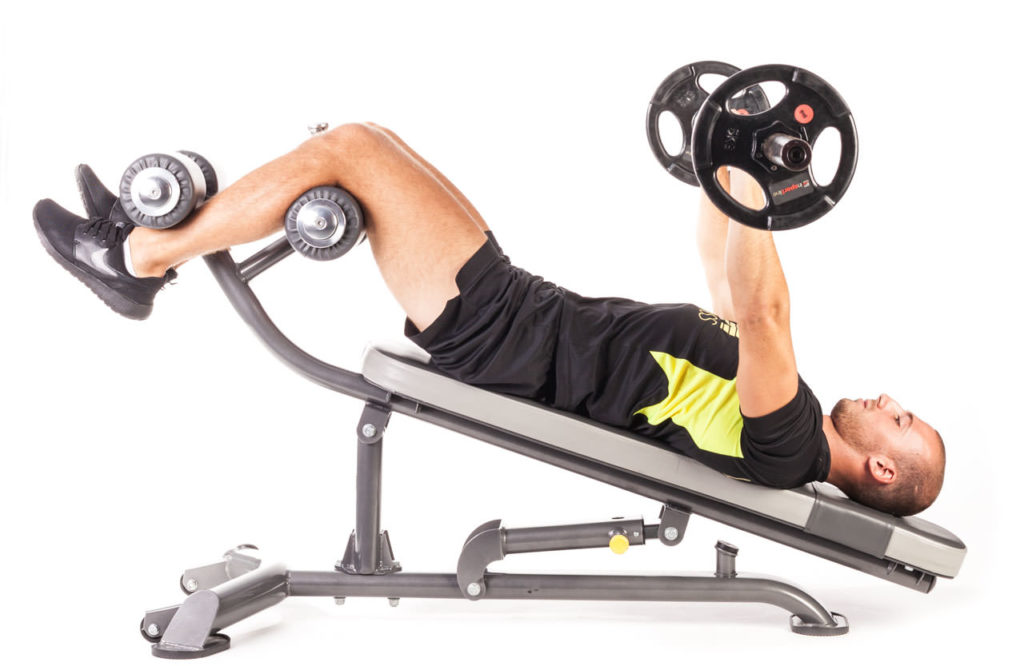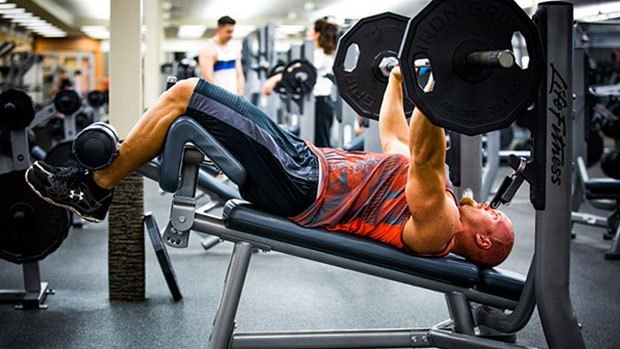Decline Barbell Bench Press manages to be a strength gaining exercise which would help in training the upper body. The main part it targets is the chest muscles. Today it’s the most demanding option for those who are into bodybuilding profile. Legends like jay cutler and Dorian Yates prefer doing this exercise for their pectoral development.
This works quite harder on the chest than that of the flat and incline bench presses. Indeed the decline bench press delivers quite less stress on your shoulders in comparison to flat counterpart.

Decline Barbell Bench Pres Impact
As a gyming instrument, the decline barbell bench press is an effective flat bench alternative. This would change the angle and tension placed on the chest. Its performances manage with increasing the likelihood of the new stimulus to the working muscles and that would lead to an increased probability of muscle growth in size and strength. But when the decline bench press is considered it sometimes favoured over the flat bench in terms of shoulder impingement which are rather the best benefits of the exercises.
With research, it is found that the decline press is underperformed simply for its lack of machismo.
But it is an exclusive exercise shown to complement a chest routine. If it’s a well-balanced exercise, that would include flat, incline and decline press which is greatly going to improve muscle imbalance and increase strength. As per various studies, it’s confirmed that chest press variation is quite an important component that would maximize performance. With varying angles of your press, it can help reduce the stress on the shoulders, elbows and wrists. This would permit an increase in training volume without compromising work to the chest muscles.

Decline Barbell Bench Pres Types
1. The normal decline barbell bench press
As an exercise, the decline barbell bench press is a wonderful work out to perform.
- At first, lie down to keep your back on the decline bench and your legs get securely locked at the end of the bench.
- Use a medium width grip which can create an angle of 90 degrees between your upper arms and forearms. This can be done to lift the barbell from the squat rack and press it overhead until your arms are locked. Do make sure that your arms are perpendicular to the ground. Then pause for a second in this starting position.
- Slowly bring down the bar until you feel it on the lower chest.
- Take a brief pause and then push the barbell with your chest muscles to bring it back to the initial position. After locking your arms, just squeeze your chest to achieve the maximum contracted position.
- Next hold for a few second before coming down with the barbell again.

2. Wide grip decline bench press
The exercise can be performed step by step as like the normal form of decline barbell bench press but the difference is with a wide, pronated grip with placing each hand 3-4 inches away from the shoulder width.
- Lift the barbell from the squat rack with your hands positioned 3-4 inches wider than the shoulder width and press the weight overhead.
- Slowly bring down the bar until you feel it on the lower chest.
- take a brief pause and push the barbell with your chest muscles to bring it back to the initial position.
Tips for Decline Barbell Bench Press:
- With a great experience to supervise your movement if you don’t obtain any prior experience in doing the exercises then you can start on with lighter weights and that would be better if you don’t find any help from someone.
- Don’t let the barbell deviate far forward. It must touch the lower chest.
- Take a complete control of the movements and don’t allow the barbell to bounce off your chest.
Benefits of Decline Bench Press
The declined barbell bench press truly helps with flattening your chest. This is beneficial than the standard bench press for building chest strength and size. Looking forward to some of its benefits like;-
1. Serves less stress on the shoulders
This is quite convenient to use than the traditional bench press which involves a lot of rotation at the shoulders that potentially causes impingement. This is going to limit the range of motion and puts shoulders in a compromised position that leads to injury.
2. Less stress in the lower back
While on the bench there are chances of arching the back. This would put immense stress on the lower back. So doing this frequently would cause back pain and especially in the lumbar spine.
3. Increases pec activation
Benching at a decline minimizes rotation at the shoulder, shifting stress from the anterior deltoids to the pectoralis major. The EMG analysis has revealed that the decline bench helps in activating the fibres of the sterna head of the pectoralis major.
4. Helps with multipurpose movement
A simple adjustment like that of altering the hand placement or even varying the degree of decline can significantly change the focus of the exercise.
Improper breathing technique:
In every exercise breathing is an important part and specifically, it’s important in weight lifting. Many a time’s people hold their breath during the hardest part of the moment. This leads to internal body pressure. So it’s important to stay in tune with the body and breathing during the exercise. It is important to inhale slowly as lowering the bar to the chest reason and exhale during the explosive push up for starting the position of the decline press.
Conclusion:
For any kind of weight training, it is important to take attention to the body position, form and function. So as to perform any kind of exercise where resistance is a major concern improperly can increase the risk of injury. So it’s always necessary to take a spotter during the exercise for safety purpose. Since the weights are a major concern which sits directly overhead during the exercise. A regular grip is always recommended up on the bar instead of a false grip.

